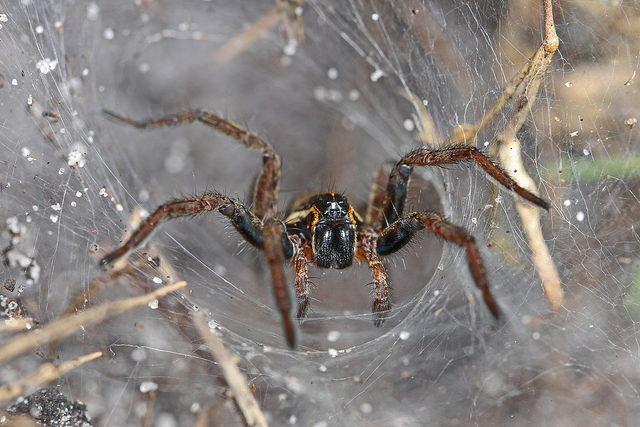Some spiders you have to be aware of and careful around, although very few are actually aggressive.
Understanding spiders can help you navigate spaces spiders inhabit and may make you think twice about squashing them; here are some myths most of us believe that just are not true.
All Spiders Make Webs
Spiders are known for their webs, but not all of the little guys are gifted web ‘designers.' ESezer/Thinkstock
For many folks, the first thing that comes to mind when talking about spiders is the idea that these creatures were born to spin webs. The truth is, not all spiders spend their days creating them.
The intricate and surprisingly sturdy nets that many spiders produce is an important part of how some of these creatures put food on the table. They use the webs to trap insects and other prey to feast on later. Other types of spiders, however, hunt the old-fashioned way. Wolfspiders, for example, burrow into the ground. They use rocks and spin silk funnels to fortify their bunkers in the winter months and they stalk prey openly for food.
Tarantulas also hunt on foot, and shoot silk streams, Spider Man-style, to keep a grip on slippery surfaces. Runningcrabspiders, named for their crustacean appearance, get their food by playing dead. They lie in wait motionless and ambush insects as they pass by.
If You Find a Spider Indoors, Set it Free
If you have a soft spot for the spiders dwelling within your home, think twice about placing them outside.
That's kind of like taking the leash off of your living-room-dwelling dog, giving the old boy a pat on the back and telling him to enjoy his new life of freedom out in the wild. Like pets, zoo animals and newly married husbands, spiders become domesticated pretty quickly. That includes common house spiders who have adapted to like the inside over many generations. You may feel like you're setting the little fella free, but you're probably handing him a one way ticket to a quick ending.
Less than 5 percent of all house spiders have ever been outside. Even fewer are adapted to the outdoor life of changing temperatures and conditions, not to mention a whole new world of predators. “Human property rights mean nothing to other species,” The University of Washington's Burke Museum arachnid curator Rod Crawford wrote on the museum's website. “There was spider habitat for millions of years where your home is now. My advice is, just wave as they go by.”
Spiders Are Aggressive
We've all blamed an unexplained blemish on a spider at some point, but maybe we're being a bit unfair to our hairy, eight-legged friends.
People tend to assume that a variety of bumps and blemishes are the work of unidentified spiders who roam their homes when the lights go out and feast on their skin until the morning comes. That's a product of at least two separate myths: One about spiders being naturally aggressive and the other about them being nearby all the time.Spider bites are actually far less common than many people think. Like most creatures, a spider's natural instinct when trouble arises is to run and hide. That includes hobo spiders, those eight-legged critters often found in homes. These poor guys suffer from limited vision and their movements can be misinterpreted as aggression. Even the brown recluse and black widows — two types of spiders whose bites actually can do some damage to humans — are unlikely to sink their teeth into you unless provoked.
The pros say that unless you catch a spider in the act of digging in, the marks on your skin were probably caused by something else.
Spiders Are Always Nearby (3 Feet Rule)
Yes, spiders inhabit most areas of the world — but one isn't always just a few feet away.
It's been often repeated that spiders are always just 3 or 6 feet (1 or 2 meters) away, depending on your Internet source. But it really depends on where you are.
If you're having a picnic in the park or hanging out in your back yard, then you're probably surrounded by tiny spiders. If you're in an airplane or at the top of a skyscraper the nearest arachnid may be miles away. Closer to Earth, golf courses and other turf settings are often spider-free because they're so heavily managed by groundskeepers. Many spiders tend to stay in their burrows come winter, especially in northern areas, meaning they are unlikely to swarm if you step outside for a snowball fight.
What we do know is that most types of spiders are limited to different parts of the world. Brown recluse spiders, for example, can be found from one side of the U.S. to the other, but rarely move above the Mason-Dixon line. Hobospiders, on the other hand, seem to prefer more moderate climes and are commonly found in northern regions of North America.
Understanding spiders can go a long way towards appreciating them, which is important, given their role in helping to control insect populations, particularly within homes.
In a survival situation (or everyday life,) understanding them can help you avoid a bite as well as not over-reacting if you find one in its natural habitat.
To learn more about spiders and other creepy crawlers, check out How Stuff Works.
Featured Image via Flickr

Shari Heastont- McCombs